Moniek Bloks's Blog, page 24
January 30, 2025
The Danish Ruby Parure Tiara
The Danish Ruby Parure began its life in the hands of Désirée Clary, the future Queen of Sweden.
Her husband, then still only Jean-Baptiste Jules Bernadotte, ordered the suite for Emperor Napoleon’s coronation from a jeweller in Paris. The entire suite consisted of a necklace, earrings, a brooch, and hair ornaments. Désirée wore the parure as she carried the new Empress Joséphine’s veil and handkerchief on a pillow during the coronation.
Embed from Getty ImagesEmbed from Getty ImagesEmbed from Getty ImagesThe parure’s next owner was Désirée’s daughter-in-law, Joséphine of Leuchtenberg. She gave the parure to her granddaughter Princess Louise when she married the future King Frederick VIII of Denmark. This was fitting as the colours of the set matched the colours of Denmark.
Embed from Getty ImagesSince then, it has remained in Denmark. It was Queen Ingrid who transformed the two hair ornaments into a full-blown tiara. She bequeathed the set to the future King Frederik X of Denmark upon her death in 2000. His future wife, Mary Donaldson, wore the set shortly before their wedding in 2004. The set has become one of Mary’s most-worn jewels.1
Embed from Getty ImagesThe post The Danish Ruby Parure Tiara appeared first on History of Royal Women.
January 28, 2025
Maria Anna of Austria – The loss of a daughter
Maria Anna of Austria was born on 27 October 1835 as the daughter of Sophie of Bavaria and Archduke Franz Karl of Austria. She was their fourth child, although Sophie had already suffered at least six miscarriages as well. Her elder brother became Emperor Franz Joseph I of Austria in 1848. Following the birth, Sophie’s brother wrote to her husband saying that “the newborn may resemble her mother in all respects, and that she may become good and beautiful like Sophie!”1
Epilepsy ran in the House of Habsburg and probably went as far back as Ferdinand I, Holy Roman Emperor, whose young son John likely had it, and he died of it before his first birthday.2 In his daughter Elisabeth, the signs of epilepsy appeared later in life.
Sophie feared that any of her children would be afflicted with epilepsy, and her fear came true when the first signs appeared in Maria Anna.3 Because of her epilepsy, Maria Anna was known in the family as “Joanna the Mad” after her famous ancestress, Queen Joanna of Castile.4
Little Maria Anna was subjected to leech therapy after ten days of seizures, and her hair was also shorn. After she complained of headaches, six leeches were applied to her forehead and nostrils despite her fierce resistance. In any case, the leech therapy did not help.5
On 5 February 1840, the seizures lasted for an entire day, and she died later that evening. Sophie wrote sadly, “I myself closed her dear and beautiful eyes.”6 She added, “My poor boys are so touching in their pain, especially Franzi, who feels it most deeply. Today he asked me to keep a picture that Anna loved so much… I beg you on my knees, dear mother, to come to me… I feel that I can and must live without my beloved child, and that I have been too happy up to now, which I have recognised with heartfelt thanks to God, but often with horror. I also like to remain quiet without complaining under God’s hands, which rests all the more heavily on me. My poor Franzi is so deeply affected by the loss of his sister that, considering his age, this hurts me more than it does me any good. He touches me extraordinarily with his constant desire to please me in order to spare me any grief… He doesn’t know what to do with himself, he doesn’t open up like his broithers, but he feels all the more deeply.”7
A few days later, she wrote, “The more clear it becomes to me through the ever longer separation that I shall never see my beloved child again in this life, never again hold her close to my impoverished heart – the more I suffer – and often so inexpressibly that I can only imagine it. How one can endure such pain without a firm faith and love for God…”8
Following Maria Anna’s death, Sophie could not bear to see her daughter’s organs removed as was usual. She said she was reluctant to “see my child’s insides in St. Stephem’s Church and her heart within the Augustinians, so dismembered in the city.”9
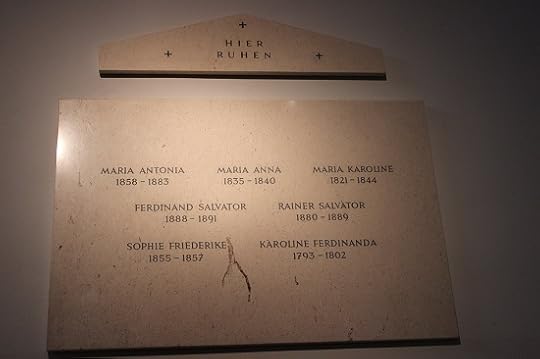 Photo by Moniek Bloks
Photo by Moniek BloksMaria Anna was interred in the Imperial Crypt in Vienna.
The post Maria Anna of Austria – The loss of a daughter appeared first on History of Royal Women.
January 26, 2025
Princess Wei Guafuren – The mourning Princess
Princess Wei Guafuren (also known as The Widow of Wei) had a tragic life. Her life is still largely unknown.[1] If it hadn’t been for the beautiful and sad poem that she had composed, she would have been entirely forgotten in history.[2] Princess Wei Guafuren was engaged to the Duke of Wei.[3] Once she arrived, her betrothed died before she could marry him.[4] Her brother-in-law tried to marry her, but she chose a life of widowhood.[5] Princess Wei Guafuren has often been praised for being loyal and steadfast in her widowhood.[6]
Princess Wei Guafuren was born during the Spring and Autumn period (which lasted from 771 to 453 B.C.E.).[7] During this period, Chinese states were declaring their own independence from the ruling Zhou Dynasty to form their own dynasties.[8] Her name is unknown. Wei was the state where she lived during her widowhood.[9] She was a Princess of the State of Qi (in modern-day Shandong Province).[10] Her father was the Duke of Qi.[11] Historians are still trying to determine which Duke of Qi he was.[12]
Princess Wei Guafuren was given in marriage to the Duke of Wei.[13] Some historians believe he was Duke Xuan of Wei, but his name is still heavily disputed.[14] Once she arrived in the State of Wei, her bridegroom died.[15] Even though she did not officially have the opportunity to marry him through a ceremony, women at the time were considered married upon their betrothal.[16] Princess Wei Guafuren was advised to return home, but she refused.[17] Instead, she stayed in Wei and began her three years of mourning for her husband.[18]
During Princess Wei Guafuren’s three years of mourning for her late husband, she received a marriage proposal from her brother-in-law, the new Duke of Wei.[19] She refused his proposal.[20] Her brother-in-law asked her brothers in Qi to persuade her to marry.[21] However, she continued to refuse and vowed to remain faithful to her late husband.[22] She composed “Ode 26”[23] in The Book of Songs. It goes:
“My heart is not a stone;
It cannot be rolled
My heart is not a mat;
It cannot be folded away.
…
My sad heart is consumed, I am harassed
By a small host of men.
…
Sorrow clings to me
Like an unwashed dress.
In the still of the night, I brood upon it
Long to take wing and to fly away.”[24]
It is unknown when Princess Wei Guafuren died.[25] Even though Princess Wei Guafuren led a tragic life, she has often been seen as a model of a “chaste and obedient”[26] wife. She has been praised “for not violating her widowhood.”[27] Princess Wei Guafuren’s poetry has also moved many readers.[28] Her poem teaches readers that “suffering hardship without complaint and enduring indignities without resorting to what is improper that one can finally achieve one’s goals”[29]. Thus, the life lessons in Princess Wei Guafuren’s poem will continue to inspire and teach many generations.[30]
Sources:
Cook, C. A. (2015). “The Widow of Wei”. Biographical Dictionary of Chinese Women: Antiquity Through Sui, 1600 B.C.E. – 618 C.E. (L. X. H. Lee, Ed.; A. D. Stefanowska, Ed.; S. Wiles, Ed.). NY: Routledge. pp. 81-82.
Eno, R. (2010). 1.7. Spring and Autumn China (771-453). Indiana University, PDF.
Liu, X., Kinney, A. B. (2014). Exemplary Women of Early China: The Lienü Zhuan of Liu Xiang. United Kingdom: Columbia University Press.
Waley, A. (1937; 1969). The Book of Songs. London: George Allen & Unwin.
[1] Liu & Kinney, 2014
[2] Cook, 2015
[3] Cook, 2015
[4] Cook, 2015
[5] Cook, 2015
[6] Cook, 2015
[7] Eno, 2010
[8] Eno, 2010
[9] Cook, 2015
[10] Cook, 2015
[11] Cook, 2015
[12] Cook, 2015
[13] Cook, 2015
[14] Liu & Kinney, 2014
[15] Cook, 2015
[16] Liu & Kinney, 2014
[17] Cook, 2015
[18] Cook, 2015
[19] Cook, 2015
[20] Cook, 2015
[21] Cook, 2015
[22] Cook, 2015
[23] Cook, 2015, p. 82
[24] Waley, 1937; 1969, p. 71; Cook, 2015, p. 82
[25] Cook, 2015
[26] Cook, 2015, p. 82
[27] Cook, 2015, p. 82
[28] Liu & Kinney, 2014
[29] Liu & Kinney, 2014, p. 70
[30] Liu & Kinney, 2014
The post Princess Wei Guafuren – The mourning Princess appeared first on History of Royal Women.
January 25, 2025
Book News Week 5
Book News Week 5 – 27 January – 2 February 2025

Warrior Queens & Quiet Revolutionaries: How Women (Also) Built the World
Paperback – 30 January 2025 (UK)
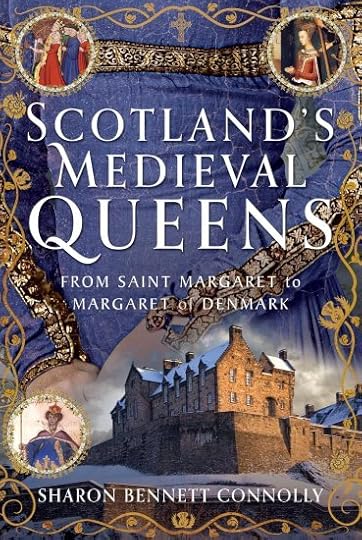
Scotland’s Medieval Queens: From Saint Margaret to Margaret of Denmark
Hardcover – 30 January 2025 (UK)
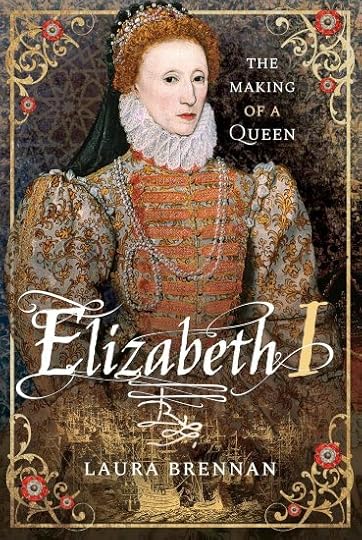
Elizabeth I: The Making of a Queen
Paperback – 30 January 2025 (UK)
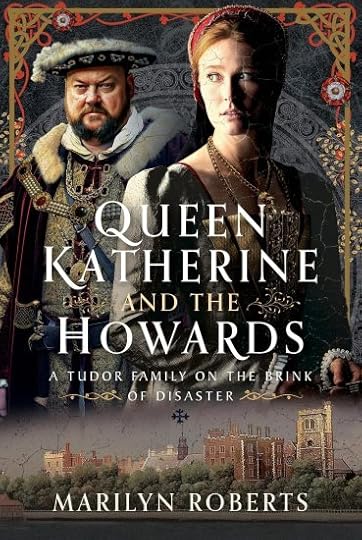
Queen Katherine and the Howards: A Tudor Family on the Brink of Disaster
Hardcover – 30 January 2025 (UK)
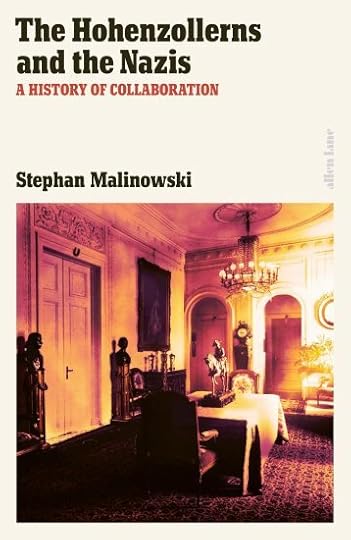
The Hohenzollerns and the Nazis: A History of Collaboration
Kindle Edition – 30 January 2025 (US)
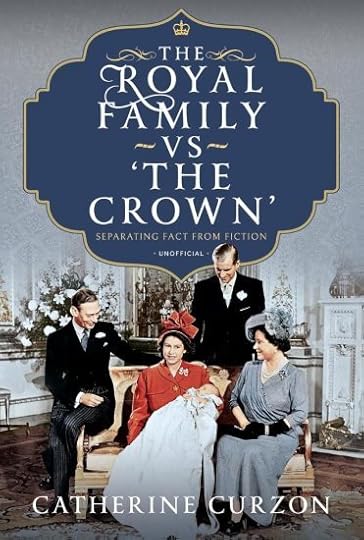
The Royal Family vs ‘The Crown’: Separating Fact from Fiction
Hardcover – 30 January 2025 (UK)
The post Book News Week 5 appeared first on History of Royal Women.
January 24, 2025
Five royal uncle-niece marriages (Part five)
Royal uncle-niece marriages happened several times over the years. These marriages often happened for strategic reasons, such as land or power, but also because of rank and status. There simply weren’t enough others of high enough rank for marriage. The offspring of such marriages often suffered from genetic abnormalities, such as the famous Habsburg jaw. Quite often, these children did not survive to adulthood.
Here are five more of those marriages:
21. María Amalia of Spain & Infante Antonio Pascual of Spain
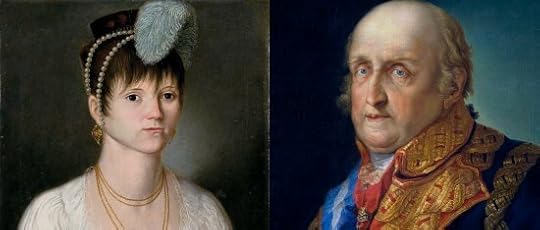 (public domain)
(public domain)María Amalia of Spain was born on 9 January 1779 as the daughter of the future King Charles IV of Spain and Maria Luisa of Parma. Her mother had arranged for her to marry her first cousin, the future King Louis I of Etruria, but he preferred her younger sister, Maria Luisa. The groom had to be replaced quickly, and finding one of suitable rank proved to be a challenge. Therefore, a marriage was arranged with her uncle, Infante Antonio Pascual of Spain, who was 24 years older than her. They married in a double wedding with her sister and her previous fiance. She died in childbirth with their first child on 22 July 1798. Her son was stillborn.
22. Countess Louise Auguste Henriette of Stolberg-Stolberg & Joseph Christian Ernest Louis, Count of Stolberg-Stolberg
Countess Louise of Stolberg-Stolberg was born on 13 January 1799 as the only child of Frederick Charles August Alexander, Hereditary Count of Stolberg-Stolberg and Countess Marianne Diderica Frederica Wilhelmine von der Marck. Her parents divorced the same year she was born, and both remarried twice. Her father had no sons and died in 1805, leaving his younger brother, Joseph, as the next Count of Stolberg-Stolberg. On 22 May 1819, Louise married her uncle, who was 28 years older than her. They went on to have five children together, including her heir, Alfred. Louise was widowed in 1839. Louise died on 15 August 1875, having outlived not only her husband but also two of her children.
23. Princess Sophie of Sweden & Leopold, Grand Duke of Baden
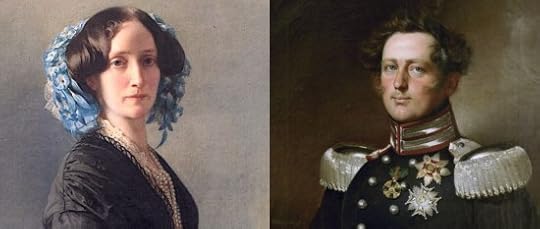 (public domain)
(public domain)Princess Sophie of Sweden was born on 21 May 1801 as the daughter of King Gustav IV Adolf of Sweden and Frederica of Baden. Her father was deposed as King of Sweden in 1809. On 25 July 1819, Sophie became engaged to her half-grand-uncle, Prince Leopold. Leopold had been born of a morganatic marriage, but the male line of the dynastic Badens was dying out, leaving only the morganatic line. In 1817, Leopold and his siblings became Princes and Princesses of Baden. Sophie was a descendant of the main Baden line through her mother, and the marriage was arranged to strengthen Leopold’s claim. He succeeded as Grand Duke of Baden in 1830. Leopold was 11 years older than Sophie. He and Sophie went on to have eight children together. Their eldest son became Grand Duke after his father, but he was deemed mentally unfit, and their second son became regent and the eventual Grand Duke. Leopold died in 1852, while Sophie died on 6 July 1865.
24. Herodias & Herod II
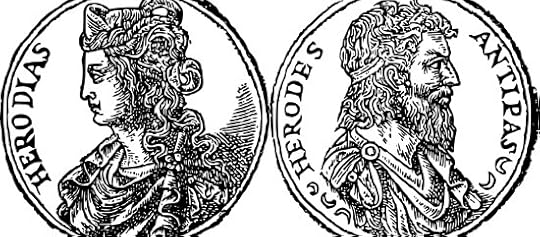 Herodias and Herod Antipas (public domain)
Herodias and Herod Antipas (public domain)Herodias was a Princess of Judea during the time of the Roman Empire. Herodias married her half-uncle, Herod “Without-Land”, and gave birth to a daughter named Salome. Her husband’s brother, Herod Antipas, fell in love with her, and they both divorced their spouses to marry one another in 27 A.D. Herodias died sometime in 40 A.D.
25. Salome & Philip the Tetrarch
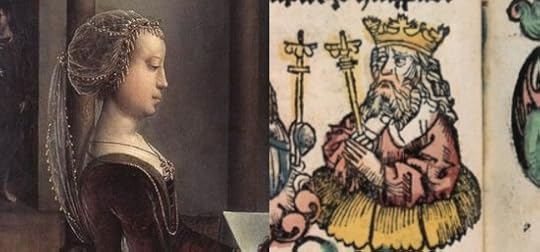 (public domain)
(public domain)Herodias’s daughter, Salome, eventually married her uncle, Herod Phillip II, the ruler of Trachonitis. They remained childless, and her husband died in 34 C.E. Salome then married her cousin, Aristobulus, the King of Armenia Minor. They had three sons together: Herod, Agrippa, and Aristobulus. Queen Salome may have died between 54 and 61 C.E.
The post Five royal uncle-niece marriages (Part five) appeared first on History of Royal Women.
January 23, 2025
Queen Elisabeth’s Art Deco Bandeau
Queen Elisabeth’s Art Deco Bandeau may be small but it has certainly been worn to some big events.
The bandeau is part of the Belgian royal family’s collection, and it’s been in the family for generations. It was made for Queen Elisabeth (born of Bavaria). It features a zig-zag design with round diamonds, and it is crossed by a diamond laurel wreath. It can be converted into a choker, and it can be worn as a traditional tiara or across the forehead.
Embed from Getty ImagesEmbed from Getty ImagesEmbed from Getty ImagesQueen Elisabeth gave the tiara to her daughter-in-law, Astrid. It was also worn by the Princess of Réthy, who married Astrid’s widower, King Leopold III. The next wearer was the future Queen Paola and she wore it regularly both as Princess of Liège and as Queen. In 1999, she lent the tiara to her future daughter-in-law, Mathilde, who wore it on her wedding day to the future King Philippe She later loaned it to her future granddaughter-in-law, Elisabetta, for her wedding to Prince Amedeo of Belgium in 2014.1
Embed from Getty ImagesEmbed from Getty ImagesIt is likely still owned by Queen Paola.
The post Queen Elisabeth’s Art Deco Bandeau appeared first on History of Royal Women.
January 21, 2025
Bianca Lancia – The Emperor’s secret wife
Frederick II, Holy Roman Emperor, had married three times for political reasons. However, according to legend, there was one woman he truly loved: Bianca Lancia.
Origin
Not much is known of Bianca’s origins. She came from the Lancia family, which was from the Aleramici dynasty and one of Northern Italy’s most powerful families. Her exact paternity is unknown, but many believe her father was named Boniface of Agliano. Her mother might have been named Bianca Maletta. Bianca is thought to have been born around the year 1210. Like most royal mistresses, Bianca is described to have been very beautiful.
Bianca and the Emperor
Bianca and Emperor Frederick are believed to have met around 1225 while he was travelling around Italy. Others suggest that they might have met later, perhaps between 1226 and 1230. When Frederick met Bianca, he was probably married to his second wife, Isabella II of Jerusalem. (His first wife was Constance of Aragon.) It is not known when Frederick and Bianca’s affair started, but she does not seem to have started to bear children until after Isabella’s death in 1228. Bianca and Frederick had three children together: two daughters, Constance and Violente, and a son named Manfred. The children were probably born between 1230 and 1233.
In 1235, Frederick married his third wife, Isabella of England, but he seems to have kept Bianca as his concubine. Bianca is usually regarded as Frederick’s favourite mistress, and some even believe she was his true love. She was given Mount Saint Angelo, the traditional dower of Sicilian queens, and her relatives were later granted fiefs in Sicily.
According to the chroniclers, Matthew Paris and Salimbene di Adam, Frederick and Bianca only married when she was dying. Due to the seven-year gap between his second wife’s death, and third marriage, some believe that Bianca’s marriage and death happened during this time, and Isabella of England was Frederick’s fourth wife. However, it seems most likely that Bianca outlived Isabella, and married and died in the 1240s. In 1247, their son Manfred was referred to as Manfred Lancia, indicating that he was illegitimate and his parents were not yet married. However, when Frederick wrote his will in 1250, he recognised Manfred as a legitimate son.
According to the chronicler Matthew Paris, Bianca, who was seriously ill or pretending to be so, begged Frederick to marry her for the salvation of her soul and the future of their children. Since Manfred was still considered illegitimate in April 1247, it is believed the marriage took place after this date. Whether she was ill or not, Bianca predeceased Frederick. When Frederick died in December 1250, he granted the castle of Mount Saint Angelo, which usually went to Sicily’s widowed queens, to Manfred rather than Bianca, suggesting that she had died by then. Her marriage seems to have benefited her children; Manfred later became King of Sicily, and her daughter, Constance, married the Byzantine Emperor. Bianca seems to have never been crowned as Queen of Sicily and the Romans, but she is referred to as so occasionally. The relationship between Bianca and Frederick is believed to have lasted for about twenty years.
Legend
Although not much was recorded of Bianca in her lifetime, her prominent position as Frederick’s mistress gave rise to many legends. According to a later legend, Frederick believed she was unfaithful to him, and imprisoned her in a tower of the Castello Normano-Svevo. The story says that she was pregnant with Manfred at the time, and Frederick thought that a page was the real father. Once Bianca had given birth, she cut her breasts off and sent them with the baby to Frederick. Frederick then believed that he had been mistaken, and rushed to the tower and found Bianca bleeding to death. He then quickly married her there before she died. After that, it is said that Bianca’s screams could be heard in the castle every night.
Sources:
Alio, Jacqueline; Queens of Sicily, 1061-1266
Hoffmann-Becking, Dirk; History of the Germans Podcast: Episode 83- The Court of Frederick II
The post Bianca Lancia – The Emperor’s secret wife appeared first on History of Royal Women.
January 19, 2025
The Duchess of Edinburgh – A business woman turned royal
Sophie Helen Rhys-Jones was born on 20 January 1965 as the daughter of Christopher Bournes Rhys-Jones and Mary O’Sullivan. She has an elder brother named David, who was born in 1963.
Her first steps into education took place at Dulwich Preparatory School. She then moved on to Kent College before entering training as a secretary at West Kent College in Tonbridge. She started working in public relations for several firms and launched her public relations agency, RJH Public Relations, in 1996.
Embed from Getty ImagesShe first met her future husband, Prince Edward, the youngest son of Queen Elizabeth II and Prince Philip, Duke of Edinburgh, in 1987 when he was dating a friend of hers. They met again in 1993 and reportedly started dating soon afterwards. Edward proposed to her while they were on vacation in December 1998, and the engagement was announced on 6 January 1999. Asked how she felt about joining the royal family, she said, “I am fully aware of the responsibilities, and I feel I am ready for it. I have had a few years to get used to it.”1 Sophie’s engagement ring was made by Garrard & Co.
Embed from Getty ImagesEmbed from Getty ImagesEmbed from Getty ImagesEdward and Sophie were married on 19 June 1999 at St George’s Chapel. Edward was created Earl of Wessex and Viscount Severn on the day of the wedding and so Sophie emerged from St George’s Chapel as Her Royal Highness The Countess of Wessex.2 Sophie wore a “long, fitted, panelled dress-coat with long sleeves and a train in ivory silk.”3 The newlyweds settled at Bagshot Park.
Embed from Getty ImagesSophie’s first pregnancy turned out to be an ectopic pregnancy, which had to be removed. On 8 November 2003, following an emergency caesarean section, Sophie gave birth prematurely to a daughter named Louise. While Louise was entitled to be called Princess Louise, her parents agreed on the less formal Lady Louise. On 17 December 2007, Sophie gave birth to a son named James, who went by his father’s subsidiary title, Viscount Severn.
Embed from Getty ImagesEmbed from Getty ImagesEdward and Sophie initially carried on with their own business ventures after their wedding, but they decided to end these in 2002. Sophie had been the victim of a newspaper sting, which had drawn much criticism concerning her dual role as a royal and a businesswoman. She “was widely attacked for allegedly using her royal status to win lucrative contracts”.4
Embed from Getty ImagesEdward and Sophie have carried out many engagements on behalf of the late Queen Elizabeth II and now King Charles III. In 2019, Edward was additionally created Earl of Forfar. On 10 March 2023, Edward was created Duke of Edinburgh, although this is not a hereditary peerage but rather a life peerage. This means that Sophie is now known as Her Royal Highness The Duchess of Edinburgh. Their son James now carries the Earl of Wessex title by courtesy.
The post The Duchess of Edinburgh – A business woman turned royal appeared first on History of Royal Women.
January 17, 2025
Five royal uncle-niece marriages (Part four)
Royal uncle-niece marriages happened several times over the years. These marriages often happened for strategic reasons, such as land or power, but also because of rank and status. There simply weren’t enough others of high enough rank for marriage. The offspring of such marriages often suffered from genetic abnormalities, such as the famous Habsburg jaw. Quite often, these children did not survive to adulthood.
Here are five more of those marriages:
16. Marie of Württemberg & Ernest I, Duke of Saxe-Coburg and Gotha
 (public domain)
(public domain)Marie of Württemberg was born on 17 September 1799 in Coburg as the daughter of Duke Alexander of Württemberg and Antoinette of Saxe-Coburg-Saalfeld. In 1830, her maternal uncle Ernest asked for her hand in marriage. He had been married to Princess Louise of Saxe-Gotha-Altenburg, with whom he had two sons, including Prince Albert, who would go on to marry Queen Victoria. They were divorced in 1826, and Louise died in 1831. He wanted a mother for his sons, and so Marie married him in 1932. Although she desperately wished for children of her own, they would not have children together. Marie had at least two miscarriages, including one which nearly cost her her life. Marie was widowed in 1844. She kept in contact with Prince Albert as his family grew. Marie died on 24 September 1860.
17. Maria Anna of Austria & Maximilian I, Elector of Bavaria
 (public domain)
(public domain)Maria Anna of Austria was born on 13 January 1610 as the daughter of the future Ferdinand II, Holy Roman Emperor and Maria Anna of Bavaria. On 15 July 1635, Maria Anna married her maternal uncle, Maximilian I, Elector of Bavaria. His first wife, Elisabeth of Lorraine, had died just a few months earlier. Maximilian was 37 years older than his bride. They went on to have two sons together, and the marriage proved to be happy. When Maximilian died on 27 September 1651, Maria Anna became the guardian of her minor son while her brother-in-law acted as regent. Maria Anna died on 25 September 1665.
18. Christiane of Saxe-Hildburghausen & Prince Eugene of Saxe-Hildburghausen
Christiane of Saxe-Hildburghausen was born on 4 December 1761 as the daughter of Ernest Frederick III Karl, Duke of Saxe-Hildburghausen and Ernestine of Saxe-Weimar. This was her father’s third marriage. On 13 March 1778, Christiane married her father’s brother, Prince Eugene of Saxe-Hildburghausen. They did not have any children together. Christiane died in 1790, and Eugene in 1795.
19. Infanta Maria Francisca of Portugal & Infante Carlos María Isidro of Spain
 (public domain)
(public domain)Infanta Maria Francisca of Portugal was born on 22 April 1800 as the daughter of the future King John VI of Portugal and Carlota Joaquina of Spain. On 22 September 1816, she married her maternal uncle, Infante Carlos María Isidro of Spain, who was 12 years older than her. They went on to have three sons together. Carlos’s elder brother, King Ferdinand VII of Spain, had two daughters, of whom the eldest, Isabella, was recognised as his heiress with the pragmatic sanction in 1830. Maria Francisca and Carlos refused to recognise her and were exiled from Spain. Maria Francisca died in England on 4 September 1834. He remarried in 1838 to a cousin named Infanta Maria Teresa of Portugal. They had no children together. Carlos died on 6 March 1855.
20. Zhang Yan & Emperor Hui
Zhang Yan, who was known formally as Empress Xiaohui, was born at an unknown date as the daughter of Zhang Ao, Prince of Zhao and Princess Yuan of Lu. In 192 BC, she married her maternal uncle, Emperor Hui of Han, and she was created Empress. They had no children together, but Empress Xiaohui adopted several children, who may have been fathered by her husband. She was widowed in September 188 BC, and one of her adopted sons became Emperor Qianshao. She died in 163 BC.
Part five coming soon.
The post Five royal uncle-niece marriages (Part four) appeared first on History of Royal Women.
January 16, 2025
The Baden Palmette Tiara
The Baden Palmette Tiara, with its heart-shaped palette motifs, is part of the collection of the Danish royals.
It was probably made in the middle of the 19th century by the jeweller Koch. It was reported to be a wedding gift from the future William I, German Emperor, to his daughter, Princess Louise. Louise married Frederick I, Grand Duke of Baden, and their daughter Victoria brought the tiara to Sweden when she married the future King Gustaf V of Sweden.
Embed from Getty ImagesEmbed from Getty ImagesUpon Victoria’s death in 1930, the tiara was inherited by granddaughter Ingrid, who married the future King Frederik IX of Denmark five years later. Many of Queen Ingrid’s jewels were divided between the family, but the Baden Palmette tiara remained in the main line, and it is often worn by her daughter, the now-abdicated Queen Margrethe II.1
The post The Baden Palmette Tiara appeared first on History of Royal Women.



